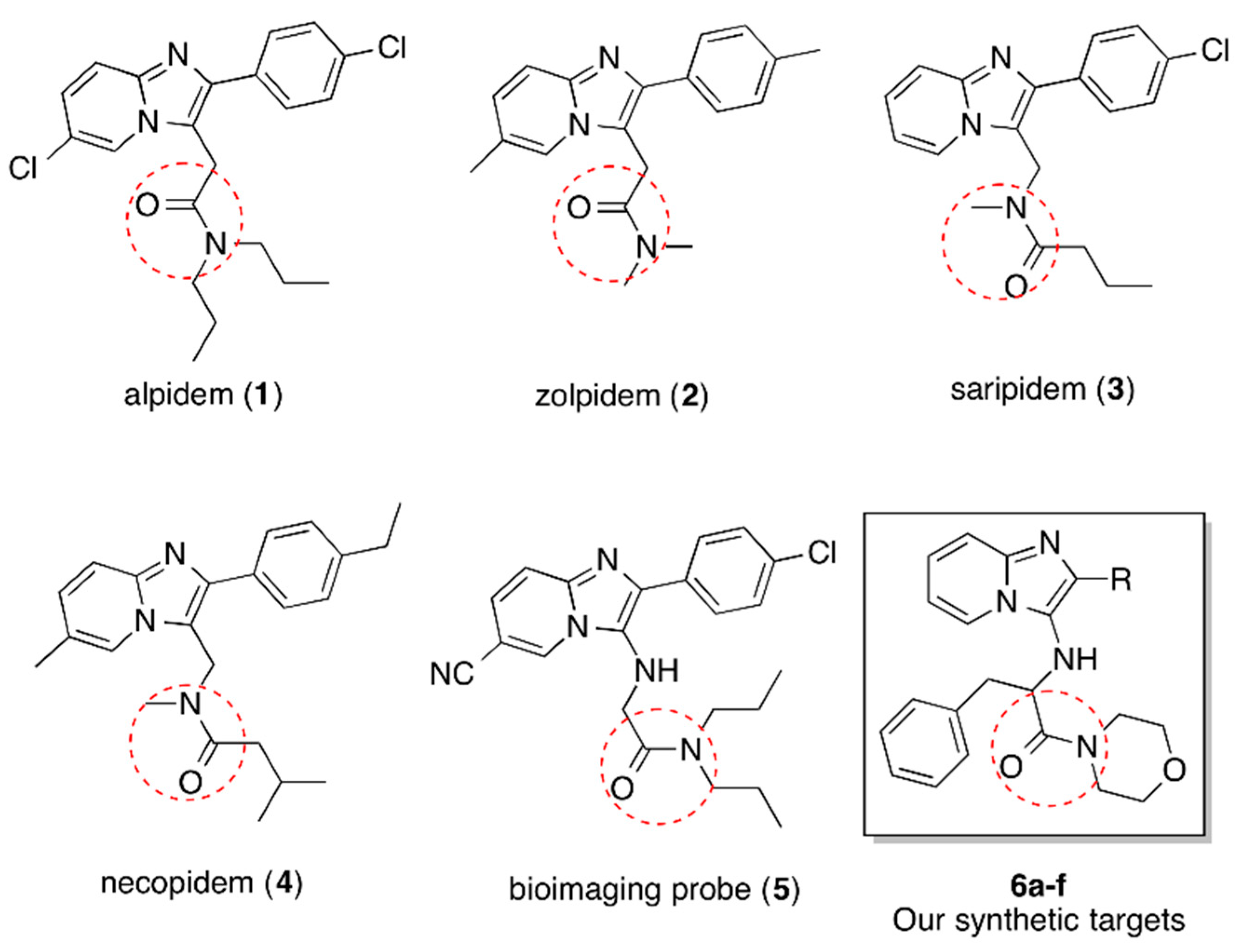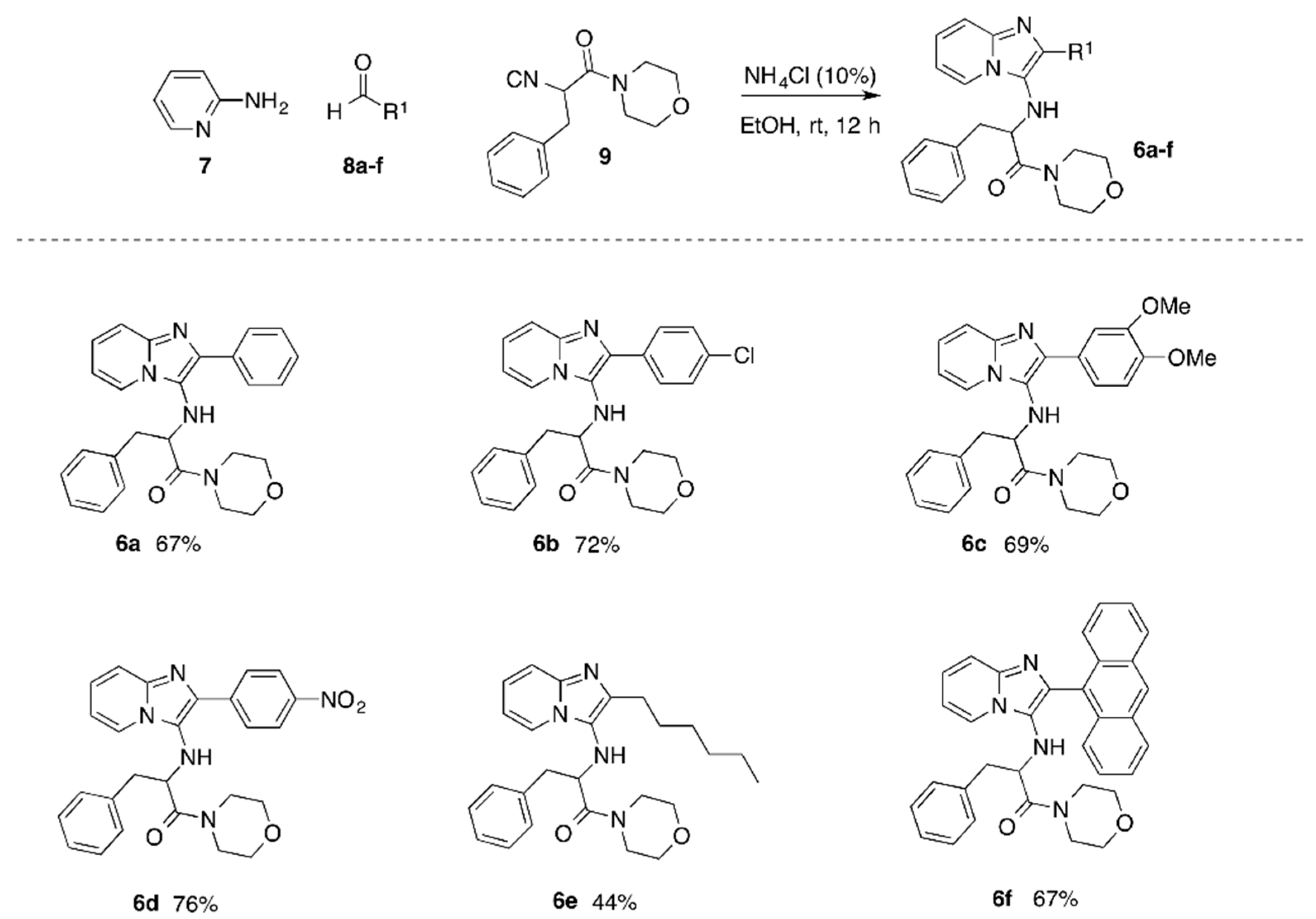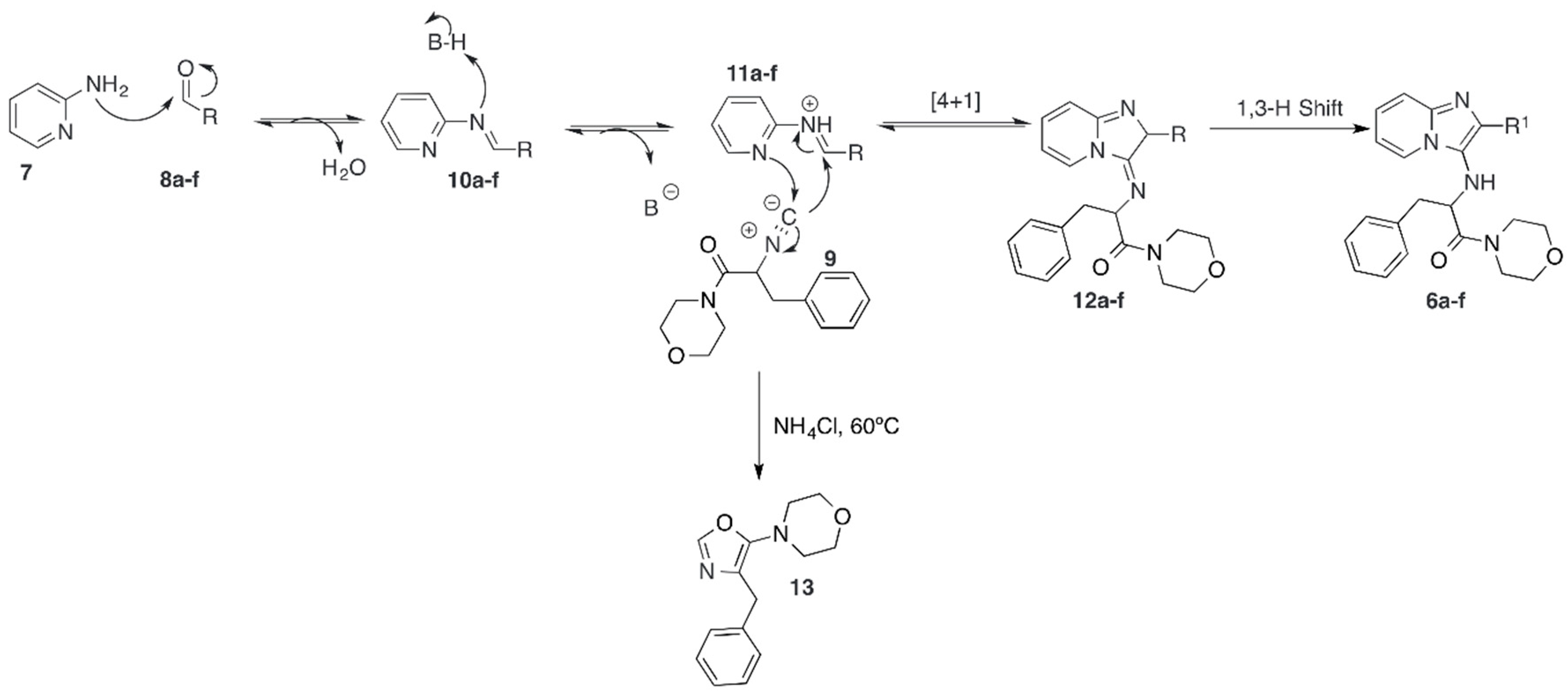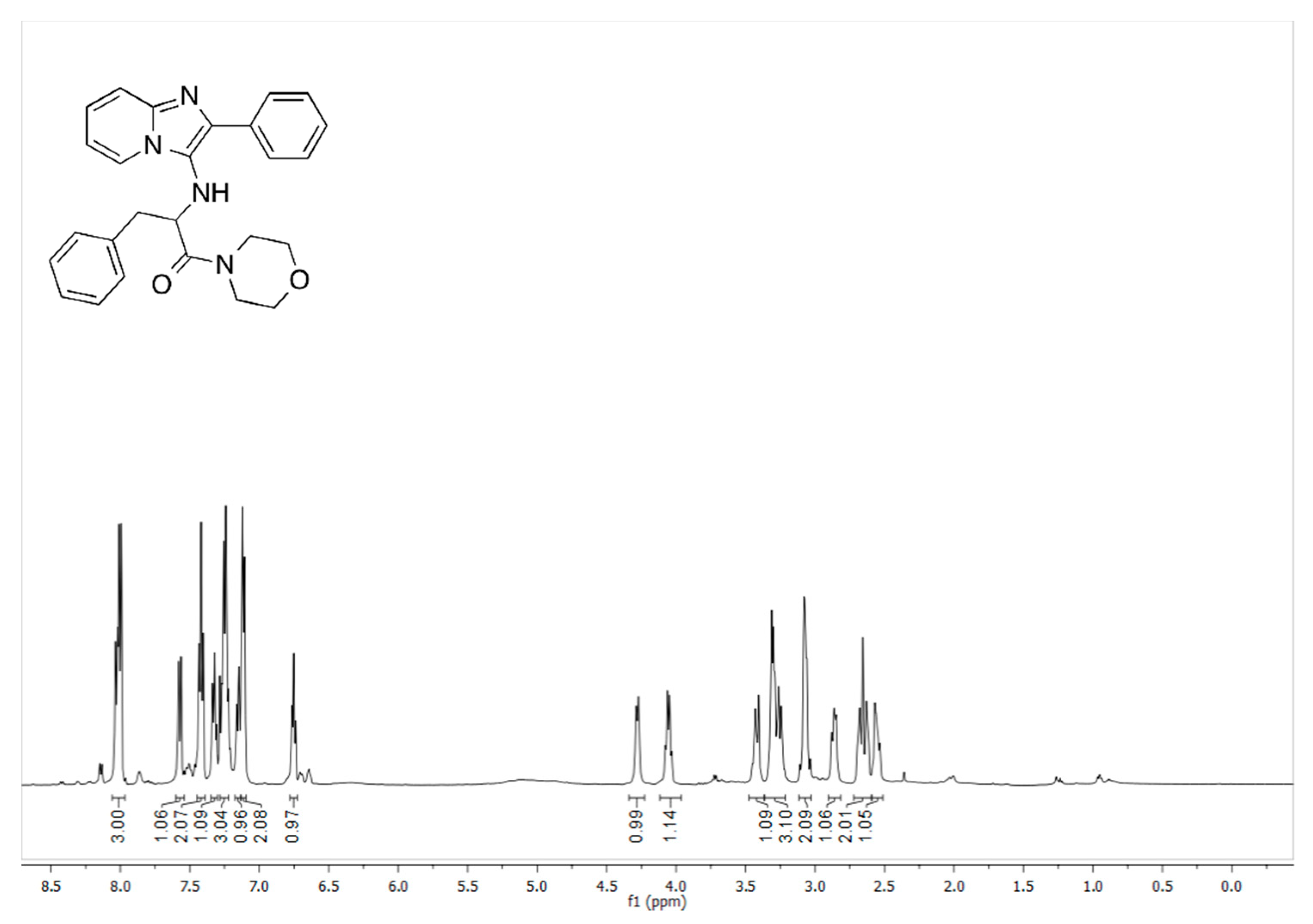Synthesis of Imidazo[1,2-a]pyridines via Multicomponent GBBR Using α-isocyanoacetamides †
Abstract
:1. Introduction
2. Results and Discussion
3. Experimental Section
3.1. General Information, Instrumentation, and Chemicals
3.2. Synthesis and Characterization of the Imidazo[1,2-a]pyridine 6a-f
1-Morpholino-3-phenyl-2-((2-phenylimidazo[1,2-a]pyridin-3-yl)amino)propan-1-one (6a)
2-((2-(4-Chlorophenyl)imidazo[1,2-a]pyridin-3-yl)amino)-1-morpholino-3-phenylpropan-1-one (6b)
2-((2-(3,4-Dimethoxyphenyl)imidazo[1,2-a]pyridin-3-yl)amino)-1-morpholino-3-phenylpropan-1-one (6c)
1-Morpholino-2-((2-(4-nitrophenyl)imidazo[1,2-a]pyridin-3-yl)amino)-3-phenylpropan-1-one (6d)
2-((2-Hexylimidazo[1,2-a]pyridin-3-yl)amino)-1-morpholino-3-phenylpropan-1-one (6e)
2-((2-(Anthracen-9-yl)imidazo[1,2-a]pyridin-3-yl)amino)-1-morpholino-3-phenylpropan-1-one(6f)
4. Conclusions
Author Contributions
Acknowledgments
Conflicts of Interest
References
- Couty, F.; Evano, G. Comprehensive Heterocyclic Chemistry, 3rd, ed.; Katritzky, A.R., Ramsden, C.A., Scriven, E.F.V., Taylor, R.J.K., Eds.; Elsevier: Oxford, UK, 2008; Volume 11, p. 409. [Google Scholar]
- Song, G.; Zhang, Y.; Li, X. Rhodium and Iridium Complexes of Abnormal N-Heterocyclic Carbenes Derived from Imidazo[1,2-a]pyridine. Organometallics 2008, 27, 1936–1943. [Google Scholar] [CrossRef]
- John, A.; Shaikh, M.M.; Ghosh, P. Palladium complexes of abnormal N-heterocyclic carbenes as precatalysts for the much preferred Cu-free and amine-free Sonogashira coupling in air in a mixed-aqueous medium. Dalton Trans. 2009, 10581–10591. [Google Scholar] [CrossRef] [PubMed]
- Enguehard-Gueiffier, C.; Gueiffier, A. Recent Progress in the Pharmacology of Imidazo[1,2-a]pyridines Mini-Rev. Med. Chem. 2007, 7, 888–899. [Google Scholar] [CrossRef]
- Devi, N.; Rawal, R.K.; Singh, V. Diversity-oriented synthesis of fused-imidazole derivatives via Groebkee-Blackburne-Bienayme reaction: A review. Tetrahedron 2015, 71, 183–232. [Google Scholar] [CrossRef]
- Volkova, Y.; Gevorgyan, V. Synthesis of functionalyzed imidazo[1,2-a]pyridines via domino A3-coupling/cycloisomerization approach. Chem. Heterocycl. Compd. 2017, 53, 409–412. [Google Scholar] [CrossRef]
- Burchak, O.N.; Mugherli, L.; Ostuni, M.; Lacapère, J.J.; Balakirev, M.Y. Combinatorial Discovery of Fluorescent Pharmacophores by Multicomponent Reactions in Droplet Arrays J. Am. Chem. Soc. 2011, 133, 10058–10061. [Google Scholar] [CrossRef]
- Pericherla, K.; Kaswan, P.; Pandey, K.; Kumar, A. Recent Developments in the Synthesis of Imidazo[1,2-a]pyridines. Synthesis 2015, 47, 887–912. [Google Scholar] [CrossRef]
- Bagdi, A.K.; Santra, S.; Monir, K.; Hajra, A. Synthesis of imidazo[1,2-a]pyridines: A decade update. Chem. Commun. 2015, 51, 1555–1575. [Google Scholar] [CrossRef]
- Groebke, K.; Weber, L.; Mehlin, F. Synthesis of Imidazo[1,2-a] annulated Pyridines, Pyrazines and Pyrimidines by a Novel Three-Component Condensation. Synlett 1998, 6, 661–663. [Google Scholar] [CrossRef]
- Blackburn, C.; Guan, B.; Fleming, P.; Shiosaki, K.; Tsai, S. Parallel synthesis of 3-aminoimidazo[1,2-a]pyridines and pyrazines by a new three-component condensation. Tetrahedron Lett. 1998, 39, 3635–3638. [Google Scholar] [CrossRef]
- Bienaymé, H.; Bouzid, K.A. New Heterocyclic Multicomponent Reaction For the Combinatorial Synthesis of Fused 3-Aminoimidazoles. Angew Chem. 1998, 110, 2349–2352. [Google Scholar] [CrossRef]
- Vicente-Garcia, E.; Kielland, N.; Lavilla, R. Functionalization of Heterocycles by MCRs. In Multicomponent Reactions in Organic Synthesis; Zhu, J., Wang, Q., Wang, M.X., Eds.; Wiley-VCH: Weinheim, Germany, 2015; Chapter 6; pp. 159–178. [Google Scholar] [CrossRef]
- Shaaban, S.; Abdel-Wahab, B.F. Groebke-Blackburn-Bienaymé multicomponent reaction: Emerging chemistry for drug discovery. Mol. Divers. 2016, 20, 233–254. [Google Scholar] [CrossRef] [PubMed]
- Che, C.; Xiang, J.; Wang, G.-X.; Fathi, R.; Quan, J.-M.; Yang, Z. One-Pot Synthesis of Quinoline-Based Tetracycles by a Tandem Three-Component Reaction. J. Comb. Chem. 2007, 9, 982–989. [Google Scholar] [CrossRef] [PubMed]
- Shaabani, A.; Soleimani, E.; Maleki, A.; Moghimi-Rad, J. A novel class of extended pi-conjugated systems: One-pot synthesis of bis-3-aminoimidazo[1,2-a]pyridines, pyrimidines and pyrazines. Mol. Divers. 2009, 13, 269–274. [Google Scholar] [CrossRef]
- Elders, N.; Ruijter, E.; Nenajdenko, V.G.; Orru, R.V.A. α-Acidic Isocyanides in Multicomponent Chemistry. In Synthesis of Heterocycles via Multicomponent Reactions I. Topics in Heterocyclic Chemistry; Orru, R., Ruijter, E., Eds.; Springer: Berlin/Heidelberg, Germany, 2010; Volume 23. [Google Scholar] [CrossRef]
- Claudio-Catalán, M.A.; Pharande, S.G.; Quezada-Soto, A.; Kishore, K.G.; Rentería-Gómez, A.; Padilla-Vaca, F.; Gámez-Montaño, R. Solvent- and Catalyst-Free One-Pot Green Bound-Type Fused Bis- Heterocycles Synthesis via Groebke-Blackburn-Bienaymé Reaction/SNAr/Ring-Chain Azido-Tautomerization Strategy. ACS Omega 2018, 3, 5177–5186. [Google Scholar] [CrossRef]
- Kurva, M.; Pharande, S.G.; Quezada-Soto, A.; Gámez-Montaño, R. Ultrasound assisted green synthesis of bound type bis-heterocyclic carbazolyl imidazo[1,2-a]pyridines via Groebke-Blackburn-Bienayme reaction. Tetrahedron Lett. 2018, 59, 1596–1599. [Google Scholar] [CrossRef]
- Puttaraju, K.B.; Shivashankar, K. Iodine-catalyzed three component reaction: A novel synthesis of 2-aryl-imidazo[1,2-a]pyridine scaffolds. RSC Adv. 2013, 3, 20883–20890. [Google Scholar] [CrossRef]
- Varma, R.S.; Kumar, D. Microwave-accelerated three-component condensation reaction on clay: Solvent-free synthesis of imidazo[1,2-a] annulated pyridines, pyrazines and pyrimidines. Tetrahedron Lett. 1999, 40, 7665. [Google Scholar] [CrossRef]
- Bode, M.L.; Gravestock, D.; Moleele, S.S.; van der Westhuyzen, C.W.; Pelly, S.C.; Steenkamp, P.A.; Hoppe, H.C.; Khan, T.; Nkabinde, L.A. Imidazo[1,2-a]pyridin-3-amines as potential HIV-1 non-nucleoside reverse transcriptase inhibitors. Bioorg. Med. Chem. 2011, 19, 4227. [Google Scholar] [CrossRef]
- Dahan-Farkas, N.; Langley, C.; Rousseau, A.L.; Yadav, D.B.; Davids, H.; de Koning, C.B. 6-Substituted imidazo[1,2-a]pyridines: Synthesis and biological activity against colon cancer cell lines HT-29 and Caco-2. Eur. J. Med. Chem. 2011, 46, 4573. [Google Scholar] [CrossRef]
- Mert-Balci, F.; Conrad, J.; Beifuss, U. Microwave-assisted three-component reaction in conventional solvents and ionic liquids for the synthesis of amino-substituted imidazo[1,2-a]pyridines. Arch. Org. Chem. 2012, 243. [Google Scholar] [CrossRef]






 | ||||
| 1 | --- | --- | rt | 10 |
| 2 | H2O | --- | rt | 8 |
| 3 | EtOH | --- | rt | 46 |
| 4 | EtOH | NH4Cl | rt | 72 |
| 5 | EtOH | I2 | rt | 49 |
| 6 | EtOH | K-10 | rt | 66 |
| 7 | EtOH | Phenyl phosphinic acid | rt | 67 |
| 8 | EtOH | NH4Cl | 60 | 49 |
Publisher’s Note: MDPI stays neutral with regard to jurisdictional claims in published maps and institutional affiliations. |
© 2018 by the authors. Licensee MDPI, Basel, Switzerland. This article is an open access article distributed under the terms and conditions of the Creative Commons Attribution (CC BY) license (https://creativecommons.org/licenses/by/4.0/).
Share and Cite
Gómez, M.A.R.; Islas-Jácome, A.; Gámez-Montaño, R. Synthesis of Imidazo[1,2-a]pyridines via Multicomponent GBBR Using α-isocyanoacetamides. Proceedings 2019, 9, 53. https://doi.org/10.3390/ecsoc-22-05692
Gómez MAR, Islas-Jácome A, Gámez-Montaño R. Synthesis of Imidazo[1,2-a]pyridines via Multicomponent GBBR Using α-isocyanoacetamides. Proceedings. 2019; 9(1):53. https://doi.org/10.3390/ecsoc-22-05692
Chicago/Turabian StyleGómez, Manuel A. Rentería, Alejandro Islas-Jácome, and Rocío Gámez-Montaño. 2019. "Synthesis of Imidazo[1,2-a]pyridines via Multicomponent GBBR Using α-isocyanoacetamides" Proceedings 9, no. 1: 53. https://doi.org/10.3390/ecsoc-22-05692
APA StyleGómez, M. A. R., Islas-Jácome, A., & Gámez-Montaño, R. (2019). Synthesis of Imidazo[1,2-a]pyridines via Multicomponent GBBR Using α-isocyanoacetamides. Proceedings, 9(1), 53. https://doi.org/10.3390/ecsoc-22-05692





